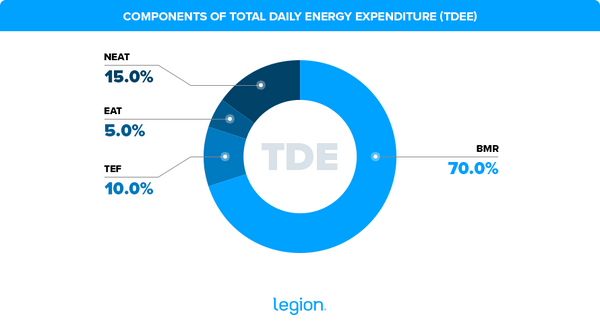Do Calories Matter?
Talk to anyone about nutrition and calories are guaranteed to come up in the conversation. Especially in the fitness world, where roided-out guys with sub-10% body fat sell you nutrition programs with all kinds of goofy tricks for satiety while focusing only on calories and macronutrients. I’d rather fly a plane without a window than go down this route. It might work for their goals of building huge amounts of muscle because they have superhuman levels of discipline to begin with. I don’t have that, and I’m also more interested in actual health than in winning sports competitions. So I prefer the quality of my food to do most of the work for me automatically, helping me to maintain impressive fitness by normal person standards with ease. From a thermodynamics standpoint, calories do matter, but not in the way that is traditionally thought.
The classic recipe for body composition goals: calories in, calories out (CICO). Denying this reality is sure to evoke skepticism from your favorite critics. While technically true, here are some nuances that are not often considered:
Calories can deviate from their listed amount on the label by up to 20%
This rule makes sense because measuring the exact amount of calories in a particular food is hard. Scientific measurements always have some margin of error. The problem is that because everyone cares about calories so much, with this generous window, food manufacturers are incentivized to underestimate the calorie amounts in their products.
The thermic effect of food
The body’s metabolic rate and heat production increase by different amounts depending on the nutrients consumed. That means digesting some foods burns more calories than digesting others. In this classic study observing the consumption of a high-protein meal versus a high-carb meal, 17% of the meal’s calories were burned digesting the high-protein meal, while 9.6% were burned digesting the high-carb meal. The exact numbers vary from study to study, but digesting protein has consistently been shown to burn more calories than digesting fat or carbohydrates.
“Calories out” is not just exercise
Energy expenditure falls into the following categories:
- Basal metabolic rate (BMR) - energy required for the body to stay alive and function properly
- Thermic effect of food (TEF) - energy required for digestion
- Non-exercise activity thermogenesis (NEAT) - movement unrelated to deliberate exercise, such as walking, fidgeting, or other daily movements
- Exercise activity thermogenesis (EAT) - deliberate exercise
The diagram below shows estimates for these energy contributions, but they can vary. As shown above, TEF can depend on the nutrient content of meals, while NEAT and EAT can obviously vary due to changes in movement each day. What’s not obvious is that BMR can also vary. The popular idea that people have genetically fast or slow metabolisms that they’re stuck with is simply false. Genetics are a factor, but lifestyle patterns are more important. A person’s BMR will increase significantly with more lean body mass because muscle is energetically expensive, which is why the body only builds muscle when it has to. We also know from research that a poor-quality diet leads to increased fat storage when compared with a control diet, even when calorie amounts are the same. So it seems that a poor diet can also reduce BMR, perhaps in part due to a reduction in brown adipose tissue thermogenesis. That’s a fancy way of saying that brown fat, a special type of fat involved with body temperature and metabolism, generates less heat, and therefore expends less energy.

Appetite can change based on dietary quality and regular exercise
This is the most important caveat of all. In the short run (no pun intended), increasing movement will increase appetite to compensate for a higher energy expenditure. The body prefers to maintain a consistent energy status, including the amount of energy stored as fat. What movement mostly helps with is metabolic efficiency through mitochondrial biogenesis, increased muscle mass, and other biological adaptations that make the body more resilient to oxidative stress. In the long run, better protection against oxidative stress means that appetite relative to energy expenditure should decrease to some degree, based on the effects of oxidative stress on appetite that I’ve written about. In other words, movement isn’t great because it burns calories, but because it builds resilience.
Still, regardless of activity level, dietary quality remains extremely important for appetite regulation; I’d argue it’s 80% of the battle at minimum. I’ve written extensively about how the types of food eaten can change the set point of the body’s preferred energy storage, also by affecting oxidative stress levels. A low-stress diet will keep appetite functioning properly, granting the freedom to eat until full without worry. Read my other posts, because the mechanisms behind this appetite control are very interesting.
Summary
Calories remain the #1 food-related concern in 2024, which is sad given the increasingly advancing state of our scientific understanding. The USDA’s promotion of the calorie budget idea in their dietary guidelines doesn’t help this cause. Calories also allow food manufacturers to fiddle with ingredients in their food to lower calorie counts, an act of smoke and mirrors that doesn’t address underlying nutritional problems. Choosing low-calorie foods simply means eating more later instead of now because the body is smart enough to regulate appetite based on energy intake. Instead, the best focus is to manage appetite at a biochemical level with proper food selection, paying little attention to calorie counts except for niche temporary circumstances, like preparing for a bodybuilding competition or making weight for a fight.